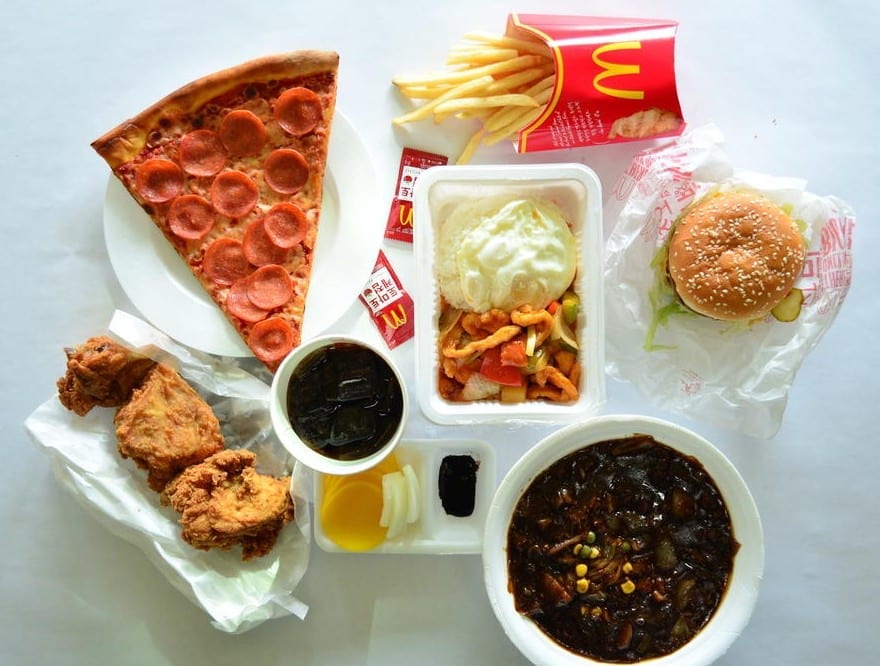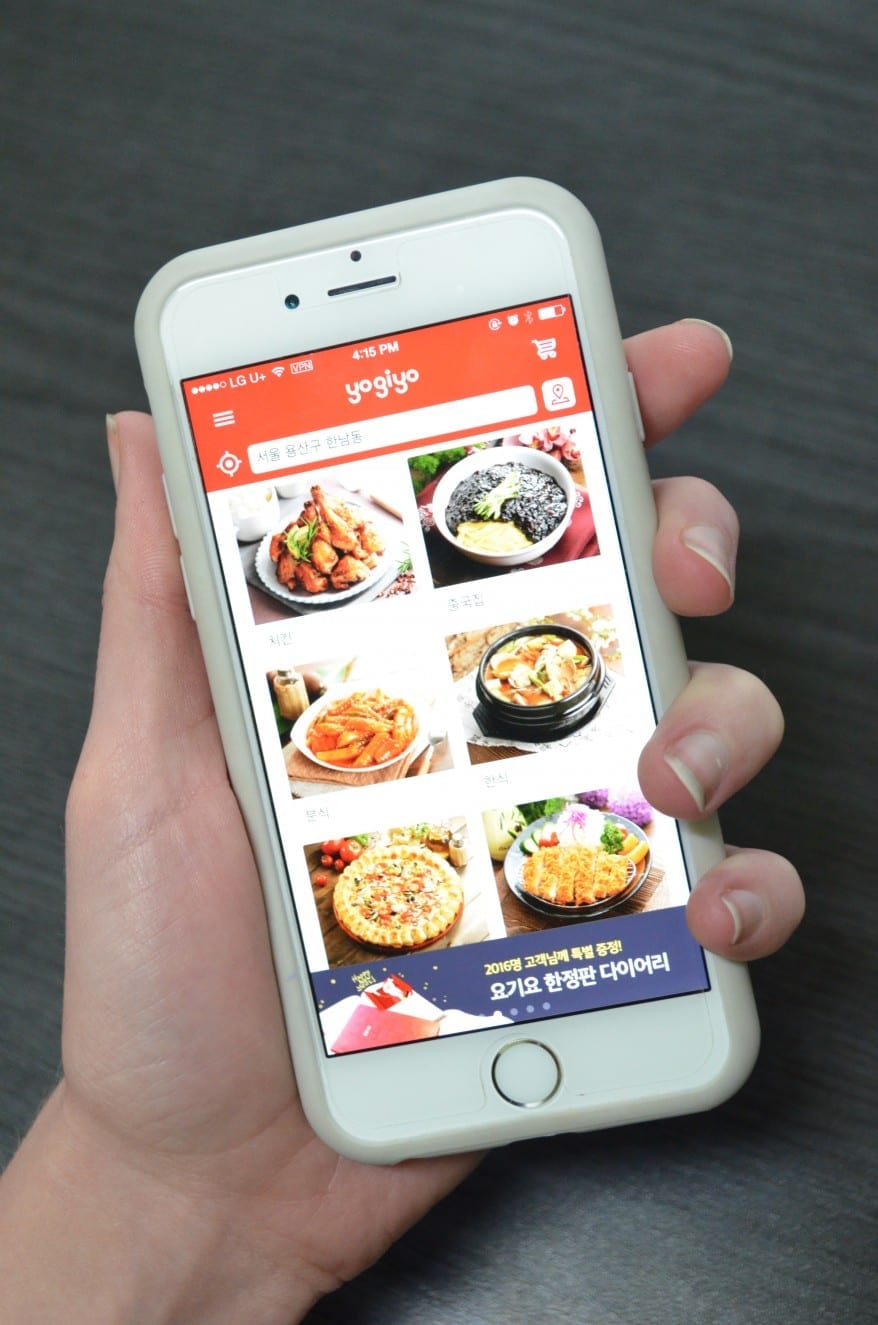January isn’t known for being happy. Dark days, failed diets and post-festive depression make for a month so grim, it includes the most depressing day of the year (typically the third Monday, in case you were wondering). Yet it doesn’t all have to be sadness and guilt at abandoning yet another New Year’s resolution. The food delivery in Korea is right on your doorstep – literally, and January’s winter depths are perfect for taking advantage of it. What used to amount to mediocre Chinese food and fried chicken now equates to a multi-billion won industry that makes high-quality food as accessible as the grocery store down the street.
Having meals delivered has always been popular in Korea, but since 2010, when homegrown delivery giant Baedaltong (“Delivery Hero” in English) introduced its award-winning click-to-call platform, things have skyrocketed. Competitor Baedal Minjok (“Delivery Nation”) appeared on the scene in 2011, and in 2012 Berlin-based Team Europe rolled out YoGiYo, a service that has since joined forces with Baedaltong. Clearly, the public was ready; in the short time since YoGiYo’s arrival, the app has been downloaded over 12 million times. These heavy-hitters between them now dominate 90% of Korea’s food delivery market, which itself is thought to be worth over 12 trillion won.
Financial worth is one thing; Korea’s fast food service is also stitched into its cultural fabric. In a recent online survey by Corea Image Communication Institute, over half of both Koreans and foreigners taking part listed fast-food delivery as their favorite aspect of Korean culture. So how did a hot meal arriving on a motorbike elevate itself to cultural status?

The “Quickly Quickly” Cliché
Even before the advent of apps and online ordering, Korea’s food delivery service was a well-oiled time-saving machine. The country’s notoriously long working hours (second only to Mexico among OECD countries), the rise of single-person households, and its “bbali bbali” attitude have always provided a rich hunting ground for delivery restaurants. Fast food delivery is the perfect alternative to coming home after a 12-hour (or more) working day, slaving over a hot stove, and then having to clean up.
These days take-out has become even more streamlined, thanks to many food delivery apps ranking restaurants by distance from the delivery address. With a bit of savvy ordering, a meal can now arrive at your house – or the park or the beach – faster than it takes to make a pot of ramen.

Spoiled for Choice
Back in the day, the idea of a gourmet meal or decent Western fare as delivery food was farcical; the reality was likely to be a choice between jajangmyeon, fried chicken or whatever the menu stuck to your door was peddling. Fast-forward to recent years and while fried chicken still rules the roost, the sheer number of restaurants accessible with just a few clicks is massive. Baedaltong alone casts the net further than the couple of blocks round your apartment to include over 150,000 listings. Also thrown into the mix are fleet services that act as food couriers for restaurants that don’t actually deliver. Many of these places don’t mark their menus up either, so the only extra cost is the delivery charge. Even mom-and-pop style set-ups have recognized that a delivery platform presence is good for business.
The net result of all this is that the selection of food available for delivery ranges from traditional Korean and the ubiquitous fried chicken to Mexican, Greek, Indian; you name it. Chances are if there’s a restaurant, there’s a delivery option.
For residents of big cities like Seoul, the choices are endless, but the unfortunate reality for everyone else is that the selection is still limited. Things could improve though. Some companies like Seoul-based Bird Riders and Ynot Takeout invite customers to suggest restaurants, neighborhoods and even cities they’ll consider expanding to if there’s enough demand. So if you have an opinion, voice it because companies are listening.
Customer Convenience and Beyond
Apps and online ordering improved on fast food delivery with click-to-call ordering – or in some cases just clicking, but things haven’t stopped there. Plenty of keen-eyed entrepreneurs are coming up with ways to improve on this blueprint, and as a result have expanded Korea’s food delivery culture in all sorts of directions.
Take Seoul’s Food Fly for instance. Its success is built on connecting customers to non-delivery restaurants whose menus are available through the Food Fly website. CEO Lim Eun-seon, speaking to Korea Joongang Daily, said he wants to bring popular restaurants and their food to the delivery market by operating like a courier service, shuttling food orders between them and their customers.
Bird Riders also use this model to focus mainly on the foreign food market. Customers can order in English or Korean on their website, and choose from a selection of mostly Western restaurants. Drivers will even stop at the convenience store on the way, to collect drinks, snacks and cigarettes. As if that weren’t enough, they give 100 won from every order to charity.
Food delivery and the convenience store are also covered by Seoul’s 해주세요 (“Please Do It”), along with any other personal errand you can think of. You just have to call them and they’ll collect prescriptions, walk the dog, wash your car – anything, in fact, that you don’t have time to do yourself.
With delivery companies offering such a wide range of personal and niche services, it’s easy to see why food delivery culture is, on the face of it, so popular.
The Downside of Delivery
Choice, speed and convenience are the Holy Trinity of food delivery; what’s good for customers is good for cash flow. Yet with so many businesses competing against each other, and so many platforms battling for consumer attention, surely someone’s being ripped off?
Cost is the main complaint from restaurants affiliated with YoGiYo, Baedal Minjok and Baedaltong, which for many is a catch-22. The presence of a listing online or through an app increases an audience, but monthly fees for advertising, extra fees for appearing earlier in the listings and even commission taken from every order can make this counterproductive. Some businesses have even seen a fall in net profits due to commission – usually between 5% and 9% – on each order. Yet opting not to advertise through these services isn’t the answer, as that limits the customer base, also risking a fall in orders and a decrease in profits.
It’s not all good news for customers ordering through apps either. There have been reports of a reduction in quality and portion size when placing orders this way, instead of calling the restaurant directly. Businesses have used these tactics to try to counteract commission fees taken by large delivery service companies.
Happily, however, businesses on Baedal Minjok have caught a break. From August, the company abolished taking commission on orders, though a monthly subscription fee still applies. They’ve made no secret of the fact this will reduce their revenue, but it’s hoped that smaller businesses will be encouraged to partner with them. If it works, other top companies could follow suit.
Delivery drivers are the ones with the toughest shift. Young drivers, often working for minimum wage to pay college tuition, are under a certain amount of pressure to get food to its destination fast. As a result, driving on pavements, breaking speed limits and jumping red lights are all in a day’s work, and have seen a rise in motorbike accidents.
Advertised delivery-time promises have been abolished, and as a result, Baedal Minjok, Baedaltong and YoGiYo have introduced measures to promote safe driving. Despite this, the general public’s “palli palli” expectations and increased competition amongst businesses still make for occupational hazards.
The Future’s Bright?
Korea’s delivery culture has exploded in popularity in an incredibly short time, and if there are warnings that the party can’t last forever, no one’s listening; the take-out sector remains a goldmine. Investors have injected billions of won into improving and diversifying services and nothing looks like it will slow down any time soon. US investment bank Goldman Sachs handed Baedal Minjok a $36 million cash boost at the end of 2014, and Delivery Hero (parent company to Baedaltong and YoGiYo) is now estimated to be worth over $3 billion.
As for where the cash will go, consumers, themselves are likely to be a driving force for the continued evolution of food delivery. YoGiYo, for example, kicked off their 24-hour service in August as a direct response to requests from its users, showing that despite its size, it’s still willing to listen and act upon consumer demand.
Other niche areas are being trialed and will expand the market even further. Delivery of fresh fruit and vegetables, supermarket shopping and specialty food where short delivery times are essential for quality are only some of the new services available.
And, of course, there is Korea’s proximity to the rest of Asia, a largely untapped wealth of food delivery investment. Success in Korea provides companies with a foot in the door to the Asian market, a sharp move by investors looking to expand into Japan, China, and beyond. So, for the foreseeable future at least, the rise of Korea’s food delivery culture looks set to continue.
Placing Your Order: As Easy As…
Whatever’s on the horizon for fast food remains to be seen. For now, though, eating your way ‘round the world from the comfort of your own home has never been easier. But where to begin?
Ordering take-out doesn’t mean being tied to a Korean-speaking friend or rolling out your best Konglish and hoping for the best – unless you want it to. Clicks are where it’s at these days, and placing an order through your PC or Smartphone is suspiciously straightforward: Create an account or register the delivery address, choose food, select a payment option and wait. If you’re new to it, you probably won’t relax until your food arrives, at which point you’ll never look back. Even if you’re completely unfamiliar with the Korean language, most sites translate to English, and the clear photos and convenient food categories make it difficult to go wrong.
If you do have to pick up the phone and put your language skills to the test, be sure to provide your address and phone number. Drivers will call when they arrive at buildings with security locks or door codes.
Finally, for the uninitiated, remember that convenience is the star of the show so the metal cutlery and reusable plates don’t have to be washed before collection (that’s right – they’re collected!). Eat your food, pile dishes outside the door, and your work is done.
Apps At-A-Glance: Six Food Delivery Services to Get You Started
 1. YoGiYo (www.yogiyo.co.kr)
1. YoGiYo (www.yogiyo.co.kr)
Where: Nationwide
How: Online, Smartphone app
Food: Various
Language: Korean, auto-translates to English
One of the top three, YoGiYo’s popularity is in its simplicity. A streamlined, no-frills layout with clear pictures and minimalist design make it easy for even the most technologically-challenged to navigate.
Instructions: Set location, choose food type and a list of restaurants in your area will appear. Make your selection, checkout and wait for a knock on the door. Simple!
Pro tip: Extensive choice and 24-hour service.
2. Baedal Minjok (www.baemin.com)
Where: Nationwide
How: Online, Smartphone app
Food: Various
Language: Korean
Another of the delivery kingpins, works in a similar way to YoGiYo, only the site is in Korean.
Instructions: Select the type of food you want, choose from the list of restaurants and place your order. It’s possible to pay through your phone contract as well as cash, card etc.
Pro tip: Cute characters and appealing graphic design make this site fun to use, but if you’re not confident with Korean – or so much visual stimulus – this might not be the one for you.
3. McDelivery
Where: 60% of McDonald’s restaurants nationwide
How: Online
Food: McDonald’s menu
Language: Korean, English
It’s worth mentioning because, for a lot of us, the most likely source of Western delivery food (other than fried chicken and pizza) will come in a brown paper bag with a pair of golden arches on it.
Instructions: Set your address, choose your food, confirm the order and select payment.
Pro tip: McDelivery is a 24/7 service.
Check out our top mobile app article for delivery and found out how to use them!






 1. YoGiYo (
1. YoGiYo (